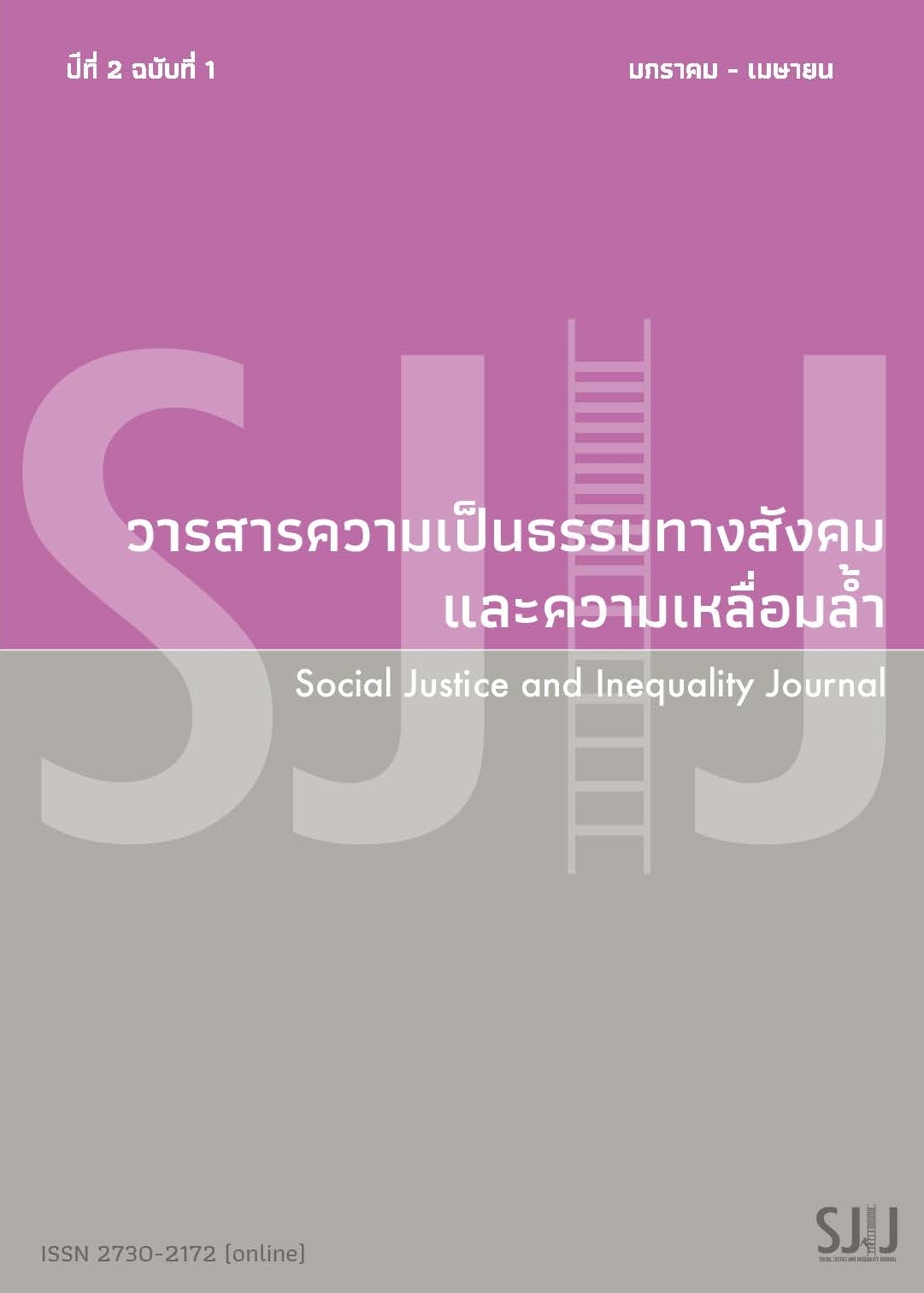Special Article: Manipulation of academic publication: gaming the system in publish-or-perish culture
กลโกงภายใต้วัฒนธรรม “เผยแพร่หรือแพ้พ่าย”
Keywords:
Academic Fraud, Publication Ethics, Citation Manipulation, Paper Mills, Predatory PublisherAbstract
แรงกดดันของนักวิจัยในการเผยแพร่ผลงานทางวิชาการเพิ่มสูงขึ้นในช่วงหลายปีที่ผ่านมามหาวิทยาลัยและสถาบันวิจัยใช้มาตรการต่างๆในการจูงใจหรือกดดันให้นักวิจัยตีพิมพ์ผลงานทั้งการให้เงินสนับสนุนหรือค่าตอบแทนการตีพิมพ์หรือการไม่ขยายสัญญาการทางานหากมีจำนวนการตีพิมพ์ที่ไม่เป็นไปตามข้อกำหนดนอกจากนี้การให้ทุนวิจัยและตำแหน่งทางวิชาการได้เน้นไปที่ตัวชี้วัดเชิงปริมาณ เช่น จำนวนบทความ จำนวนการอ้างอิงค่าดัชนีผลกระทบการอ้างอิงหรือการจัดอันดับวารสารปัจจัยเหล่านี้อาจนำไปสู่การประพฤติที่ไม่เหมาะสมในการเผยแพร่งานวิจัยบทความชิ้นนี้ต้องการให้ภาพรวมของการประพฤติผิดจรรยาบรรณการเผยแพร่งานวิจัยรวมถึงการฉ้อฉลในการตีพิมพ์อย่างเป็นระบบโดยจะกล่าวถึงรูปแบบเฉพาะต่างๆของพฤติกรรมเหล่านี้เพื่อให้ผู้อ่านและผู้เขียนงานทางวิชาการสามารถแยกแยะได้บทความนี้ยังมีจุดมุ่งหมายเพื่อสร้างความตระหนักให้กับมหาวิทยาลัยหน่วยงานให้ทุนและผู้กำหนดนโยบายวิจัยต่างๆเพื่อให้ทบทวนเรื่องการใช้ตัวชี้วัดเชิงปริมาณในการประเมินผลงานทางวิชาการเพื่อช่วยลดความเสียหายที่จะเกิดจากวัฒนธรรม “เผยแพร่หรือแพ้พ่าย”
References
Byrne, J. A., & Christopher, J. (2020). Digital magic, or the dark arts of the 21st century—how can journals and peer reviewers detect manuscripts and publications from paper mills? FEBS Letters, 594(4), 583–589. https://doi.org/10.1002/1873-3468.13747
Cobey, K. D., De Costa E Silva, M., Mazzarello, S., Stober, C., Hutton, B., Moher, D., & Clemons, M. (2017, July 1). Is this conference for real? Navigating presumed predatory conference invitations. Journal of Oncology Practice, Vol. 13, pp. 410–413. https://doi.org/10.1200/JOP.2017.021469
Committee on Publication Ethics (COPE). (2018). Systematic manipulation of the publication process. https://doi.org/10.24318/cope.2019.2.23
Committee on Publication Ethics (COPE). (2019a). Exploring publication ethics in the arts, humanities, and social sciences: A COPE study 2019. https://doi.org/10.24318/cope.2019.4.1
Committee on Publication Ethics (COPE). (2019b). Predatory Publishing: Discussion document: https://doi.org/10.24318/cope.2019.3.6
Davis, P. (2012). The Emergence of a Citation Cartel - The Scholarly Kitchen. Retrieved August 20, 2020, from https://scholarlykitchen.sspnet.org/2012/04/10/emergence-of-a-citation-cartel/
Fanelli, D. (2009). How many scientists fabricate and falsify research? A systematic review and meta-analysis of survey data. PLoS ONE, 4(5). https://doi.org/10.1371/journal.pone.0005738
Fanelli, D., Costas, R., Fang, F. C., Casadevall, A., & Bik, E. M. (2019). Testing Hypotheses on Risk Factors for Scientific Misconduct via Matched-Control Analysis of Papers Containing Problematic Image Duplications. Science and Engineering Ethics, 25(3), 771–789. https://doi.org/10.1007/s11948-018-0023-7
Fanelli, D., Costas, R., & Larivière, V. (2015). Misconduct Policies, Academic Culture and Career Stage, Not Gender or Pressures to Publish, Affect Scientific Integrity. PLOS ONE, 10(6), e0127556. https://doi.org/10.1371/journal.pone.0127556
Federal policies | ORI - The Office of Research Integrity. (n.d.). Retrieved August 17, 2020, from https://ori.hhs.gov/content/chapter-2-research-misconduct-federal-policies
Fire, M., & Guestrin, C. (2019). Over-optimization of academic publishing metrics: Observing Goodhart’s Law in action. GigaScience, 8(6), 1–20. https://doi.org/10.1093/gigascience/giz053
Grimes, D. R., Bauch, C. T., & Ioannidis, J. P. A. (2018). Modelling science trustworthiness under publish or perish pressure. Royal Society Open Science, 5(1), 171511. https://doi.org/10.1098/rsos.171511
Hardwicke, T. E., Wallach, J. D., Kidwell, M. C., Bendixen, T., Crüwell, S., & Ioannidis, J. P. A. (2020). An empirical assessment of transparency and reproducibility-related research practices in the social sciences (2014-2017). Royal Society Open Science, 7(2). https://doi.org/10.1098/rsos.190806
Ioannidis, J. P. A., & Khoury, M. J. (2014). Assessing value in biomedical research the PQRST of appraisal and reward. JAMA - Journal of the American Medical Association, Vol. 312, pp. 483–484. https://doi.org/10.1001/jama.2014.6932
Ioannidis, J. P. A., & Thombs, B. D. (2019). A user’s guide to inflated and manipulated impact factors. European Journal of Clinical Investigation, 49(9). https://doi.org/10.1111/eci.13151
Kolata, G. (2017, October 30). Many Academics Are Eager to Publish in Worthless Journals - The New York Times. Retrieved August 20, 2020, from https://www.nytimes.com/2017/10/30/science/predatory-journals-academics.html
Lao, R. (2018). Thai universities must look beyond ranking - Modern Diplomacy. Retrieved August 17, 2020, from https://moderndiplomacy.eu/2018/02/23/thai-universities-must-look-beyond-ranking/
Mallapaty, S. (2020, March 1). China bans cash rewards for publishing papers. Nature, Vol. 579, p. 18. https://doi.org/10.1038/d41586-020-00574-8
Miguel, E., Camerer, C., Casey, K., Cohen, J., Esterling, K. M., Gerber, A., … Van Der Laan, M. (2014, January 3). Promoting transparency in social science research. Science, Vol. 343, pp. 30–31. https://doi.org/10.1126/science.1245317
Misra, D. P., Ravindran, V., Wakhlu, A., Sharma, A., Agarwal, V., & Negi, V. S. (2017, November 1). Publishing in black and white: the relevance of listing of scientific journals. Rheumatology International, Vol. 37, pp. 1773–1778. https://doi.org/10.1007/s00296-017-3830-2
Nijssen, S. (2012). Salami publication. (2000), 2012. Retrieved from https://publicationethics.org/case/salami-publication
Noorbala, A. A., Bagheri Yazdi, S. A., Faghihzadeh, S., Kamali, K., Faghihzadeh, E., Hajebi, A., … Asadi, A. (2017). Trends of mental health status in Iranian population aged 15 and above between 1999 and 2015. Archives of Iranian Medicine, 20(11), S2–S6.
Patwardhan, B. (2019, July 4). Why India is striking back against predatory journals. Nature, Vol. 571, p. 7. https://doi.org/10.1038/d41586-019-02023-7
Schneider, L. (2020). The full-service paper mill and its Chinese customers – For Better Science. Retrieved August 20, 2020, from https://forbetterscience.com/2020/01/24/the-full-service-paper-mill-and-its-chinese-customers
Scientific Salami Slicing: 33 Papers from 1 Study | Information Society. (n.d.). Retrieved August 17, 2020, from http://www.informationsociety.co.uk/scientific-salami-slicing-33-papers-from-1-study/
Shamseer, L., Moher, D., Maduekwe, O., Turner, L., Barbour, V., Burch, R., … Shea, B. J. (2017). Potential predatory and legitimate biomedical journals: Can you tell the difference? A cross-sectional comparison. BMC Medicine, 15(1), 28. https://doi.org/10.1186/s12916-017-0785-9
Shen, C., & Björk, B. C. (2015). “Predatory” open access: A longitudinal study of article volumes and market characteristics. BMC Medicine, 13(1), 230. https://doi.org/10.1186/s12916-015-0469-2
Šupak Smolčić, V. (2013). Salami publication: Definitions and examples. Biochemia Medica, 23(3), 237–241. https://doi.org/10.11613/BM.2013.030
The Committee on Publication Ethics (COPE). (2000). The COPE Report 2000. In Annual Report of the Committee on Publication Ethics.
Umlauf, M. G., & Mochizuki, Y. (2018). Predatory publishing and cybercrime targeting academics. International Journal of Nursing Practice, 24. https://doi.org/10.1111/ijn.12656
Van Noorden, R. (2013). Brazilian citation scheme outed. Nature, 500(7464), 510–511. https://doi.org/10.1038/500510a
Wilhite, A. W., & Fong, E. A. (2012, February 3). Coercive citation in academic publishing. Science, Vol. 335, pp. 542–543. https://doi.org/10.1126/science.1212540
Downloads
Published
Issue
Section
License
Copyright (c) 2023 Social Justice and Inequality Journal

This work is licensed under a Creative Commons Attribution-NonCommercial-ShareAlike 4.0 International License.




